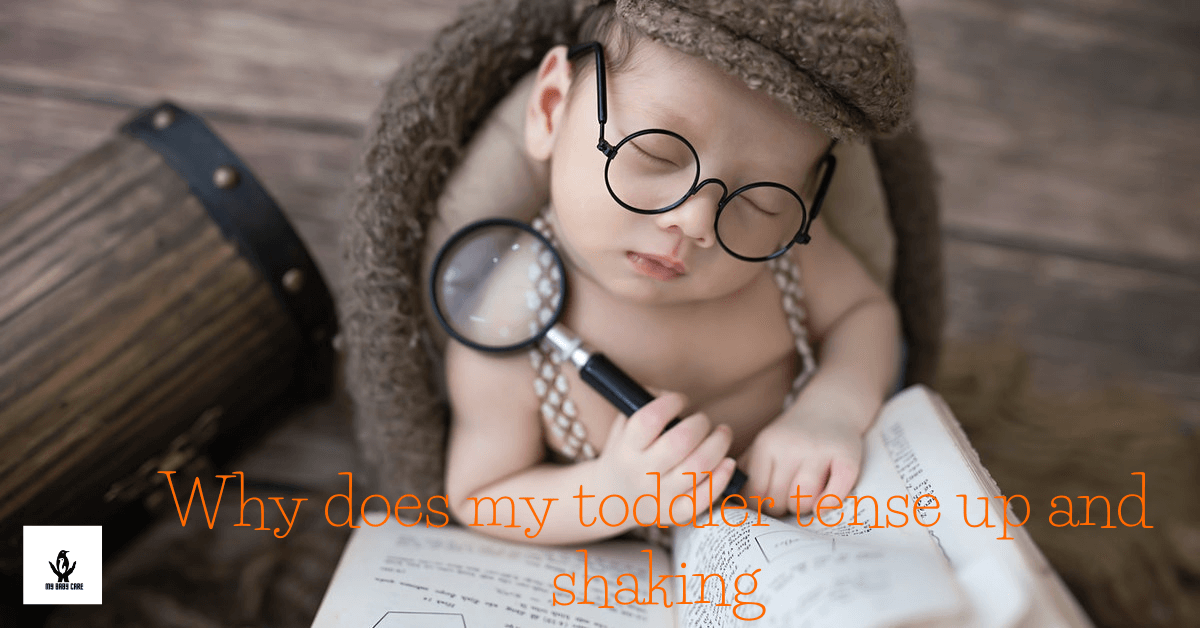The shaky movements of your kids are many kinds. Your toddler tense up and shaking due to few reasons. Sometimes these odd shaky movements can be quivering chins to trembling hands, a few jerky arm and leg gestures. Don’t worry. In most cases, these extra movements are completely normal and harmless. Your baby will surely outgrow them soon.
The toddler shaking after the excitement is a benign response to adrenaline. But if your kid shows certain symptoms such as motor stereopathy, developmental disability, or a seizure it should be under medical attention.
If the shakes present as an everyday activity especially repetitive motions or sounds it could be a sign of a tic. Often this behavior is not associated with serious medical conditions if they are growing healthy and developing normally.
But in the case of seizures, it should be highly concerned. But to identifying the particular jerky movement exactly as a seizure is a bit difficult for parents. The best thing is to get a video clip at that moment and consult a pediatrician as soon as possible whether you have a doubt.
It can clearly understand for a pediatrician after examining your kid closely when it got shaking behavior. So they decide whether it is a normal reaction to excitement or something more severe.
Most of jerky movements are odd movements. These are quivering of chins, trembling of hands and few other gestures. These movments outgrow from children with aging.
Table of Contents
1. What do they really do in sudden tensing up and shake
Normally these shaking patterns are different from child to child. Commonly they normally show excitement by tensing up their arms and legs. They start opening and closing their hands or flapping a little.
SOME KIDS DO THESE FEW ACTIVITIES AT A HIGH FREQUENCY THAN THE NORMAL CHILDREN DO . That is a unique thing to differentiate about the frequency is too much or not from child to child.
Even though they do these shaky movements at a high frequency, they have normal development. They are social and happy, also appear to be smart.
But every time they get excited about something, they sit and straighten their arms and legs then shake a little. This happens multiple times a day. Kids suddenly stop what they are doing in order to do these shaking movements for a few seconds. As an example, if they are crawling and suddenly get excited, they will sit down and do this shaking and then go back to crawling as usual.
Dear parents, this is one of the exemplary situations in that you need to get professional assistance to sort this thing out.
2. Causes for shaking when exited
1. The hormonal response
The hormonal response is the main cause of shaking when an excitement. It is non-other than the adrenaline hormone. Due to adrenalin response kids starts shaking in exciting situations. The response is a “flight or fight “ response. It controls how we react in a sudden unexpected situation. See the kind of adrenalin responses to the body
- Pupil expansion
- Lungs expansion
- Blood pressure increasing
- Heart rate increasing
- Shivering and trembling
If your kid experiences fear, excitement, stress-like feelings, their body automatically releases adrenalin hormone. It increases the heart rate, muscle contraction. That muscle contraction can cause sudden twitching or shaking of the body parts.
The Adrenalin effect is more noticeable in children as they are less inclined to control their excitement.
2. Motor stereotypes
Mostly children are excited they start to conduct repetitive, rhythmic, and fixated movements. Those movements take a specific pattern and we can call that motor stereotypes. These movements are associated with various stresses, excitement, and boredom.
There are most common motor stereotypes such as
- Biting nails
- Sucking thumbs
- Twirling hair
- Rocking body
These common motor stereotypes generate in a low frequency. These behaviors are not disruptive to the activities of daily living of the kids. Those are more likely to fade over time. But these repetitive movements are painful if children do them excessively. So dear parents, you need to point out that simply point to your kids in a law tone and calm responsive manner.
But if your child doesn’t respond to your verbal request, you need to start the second step by introducing various alternatives to the repetitive movements. This should be aimed as a preventive measure. If excessive lip licking is with your child, you can give chewing gum or a water bottle to them.
Hand flapping, wiggling, and body rotating can be considered complex motor types. The types can’t be seen frequently. If these behaviors are so disruptive, you can get medical attention to them.
3. Is it normal for babies to shake when excitement
Most of the time your child shaking when an exited situation is very normal. Because they can’t tolerate the adrenalin reaction effectively as adults. So they perform common and complex motor stereotypes. This “flight-fight ” response is a very normal thing among children.
Sometimes these motor stereotypes have differential diagnoses to the various types of other conditions such as neurodevelopmental disorders, tics, movement disorders, behavioral issues, or as “flight or fight “ responses.
Dear Parents, Don’t hurry to identify and differentiate all those signs and symptoms within your child. So It is advisable for you to get the proper professional assistance to the problem as there are a lot of things to consider.
4. When to get worried about
If you observe a sudden child shake, space out, or pass out as a seizure episode, it can consider a frightening experience. Your child can develop seizures as a result of fever, head injury, or other congenital conditions. In such cases let your pediatrician handle the problem.
Tics or tremors usually don’t associate with serious medical conditions. But normally happens as repetitive behaviors. As long as they are not disrupting the daily tasks of your kid, you don’t need to worry about that. It will resolve with time.
Shaking of body parts as a result of certain neurological conditions should consider seriously. Your health care provider should attend to that kind of problem.
If your child shaking happens due to the adrenalin effect, that also can be considered as a simple “flight-fight” response.
5. Developmental disorders – related to shaking while exited
These disorders present at any time after birth and have a negative impact on a kid’s physical, mental and socio-emotional development. If your kid is shaking in excitement with certain motor osteopathy, it may be an indication of developmental disorders like autism, mental retardation, hyperactivity, etc.
Most autism-related repetitive behaviors are misunderstood as tics or tremors or another type of fight-flight shaking of the kid. Dear parents, you need to observe whether this repetitive movement occurs on and on. That time is high time for you to get the medical attention.
6. Shaking while exited – A sign of autism
Autistic kids show various types of repetitive behaviors. These repetitive behaviors differ from child to child. Those are really complex movements to analyze. The main thing you need to consider is the frequency. Sometimes it is a motor movement, other times it is an action, body language, word, or other behavioral variation. The only thing is the relation of the particular movement.
7. Seizures related shaking while exited
If the shaking occurs with losing consciousness, It can be considered as a seizure. So you need to check whether the child is alert and conscious when shaking their body parts.
There are various signs when a seizure happens
- tremors
- staring
- rapid eye blinking
- loss of alertness
- Body stiffness
- jerky movements
- No response to words
Not all jerky movements are seizures. Tremor, tics, and shivering can occur with various body parts shaking.
8. What about tremors and tics in children
Tremors are involuntary shaking muscle movements in a healthy child sometimes appear during adolescence. These take place in arms, feet, hands, head, and legs. This can happen while the child is at rest or active.
A child can not do fine movements such as pinching, winking, or other small movements. They have limb weakness and sometimes speech impairments. Tremors differ from tics. Tic is sudden uncontrollable twitches, movements, or sounds that also occur as repetitive.
Tremors and tics are not usually associated with serious medical conditions.
9. Final Thoughts
The toddler is shaking their body parts while exiting. These are common and complex movement patterns. It is very difficult to differentiate these movements whether they are normal or due to an illness. So close medical attention is needed in several situations to identify the medical conditions related to the body shaking of kids.
There are several causes for shaking. It may be hormonal types shaky movements primarily. These are due to the flight-fight response in a tense situation. But few motor stereotypes should be considered deeply to differentiate the medical conditions such as autism, hyperactivity, developmental delay tremors, tics, etc.
I suggest that relevant medical attention is essential when shaky movements disturb your kid’s daily needs and activities.

